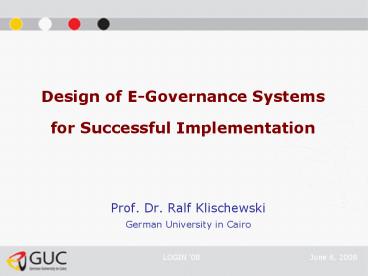Design of EGovernance Systems for Successful Implementation - PowerPoint PPT Presentation
1 / 18
Title:
Design of EGovernance Systems for Successful Implementation
Description:
E-government efficiency, cost-effectiveness & seamless, transparent, integrated ... metadata, and advance release calendar are posted on IMF's bulletin board ... – PowerPoint PPT presentation
Number of Views:50
Avg rating:3.0/5.0
Title: Design of EGovernance Systems for Successful Implementation
1
Design of E-Governance Systems for Successful
Implementation
- Prof. Dr. Ralf Klischewski
- German University in Cairo
2
Presentation Outline
- E-Governance Systems
- Successful Implementation?
- Technology Products
- Organizational Change
- Example Systems Design for Implementing the Data
Dissemination Standard in Egypt - Design
- Architecture
- Process Maturity
- Recommendation Reuse of E-Gov Assets
3
E-Governance Systems
- E-government ? efficiency, cost-effectiveness
seamless, transparent, integrated service
delivery (e.g. Bannister 2005) - E-governance ? the above plus encouraging
participation of all citizen in decision-making
and making government more accountable,
transparent and effective (e.g. UNESCO reports) - E-governance systems ? set of interrelated
(technical) components supporting e-governance
Design for successful implementation?
4
Auf dem Weg zum übergreifenden Informationsmanagem
ent
Success of Technology Implementation?
- Hardware compatibility, durability, maintenance
- Software make-or-buy, development capacity,
lifecycle management - Networks outreach, connectivity, e-readiness
- Services Applications interoperability,
scalability, serving e-governance - Technology Transfer Reuse only after careful
assessment of technological organizational
success factors
5
Auf dem Weg zum übergreifenden Informationsmanagem
ent
Success of Organizational Implementation?
- New Admin. Goals admin. processes, services,
quality (e.g. democracy) - New Admin. Organization institutional structure,
competence/responsibility, motivation,
communication (also with citizens other
stakeholders) - New User Expectation usability, transparency,
accountability, citizen participation
(e-inclusion) - Management of Design scope, time, cost,
quality, and policy compatibility
6
Design Example
- Systems Design for Implementing the
- Special Data Dissemination Standard (SDDS)
- Project sponsored by USAID in cooperation with
the Ministry of Planning, Egypt (started 2003) - SDDS ? set of guidelines by the International
Monetary Fund (IMF) for timely dissemination of
reliable macroeconomic and financial data
7
Egypts Compliance Goals
- SDDS Office established National Coordinator
designated - Data disseminated on national summary website
- Formal submission to IMF by the National
Coordinator - Data collection methodology, metadata, and
advance release calendar are posted on IMFs
bulletin board
8
Hardware Network
9
Software Connectivity
10
Information Architecture
11
Approvals in Publishing Process
12
Access Rights Approval Procedure
13
Information Sharing Strategy
14
Information Sharing Strategy (2)
15
Ministry of Economic Developments Web Site
16
Architecture Design Requirements
- E-Governance Systems / Applications /
Infrastructure - System Architecture
- Components / modules / tiers / services
- Interfaces for networking interoperability
- Information Architecture
- Structure of data being stored, processed
shared - Metadata, ontologies
- Communication Architecture
- Directories for components, services, and (key)
users - Channels for interoperability and user access
17
Design Process Maturity
- Governance for Design, e.g.
- Reflective Steps
- Tesfaye Biru
- Addis Ababa University (Diss. at Hamburg Univ.)
Overview of the Integrated Model
18
Recommendation
Reuse of E-Governance Assets
- Applications design selected e-Gov functions
once for all (e.g. registration, archive) - System Architecture Middleware standardize,
minimize variations, increase flexibility - Information Communication architecture define
and disseminate structures frameworks - Development Process define commit
methodologies, establish trainings exchanges - Organizational Change provide common visions
directions, determine train change agents - Knowledge Management include all stake-holders
expertise, share lessons learnt































